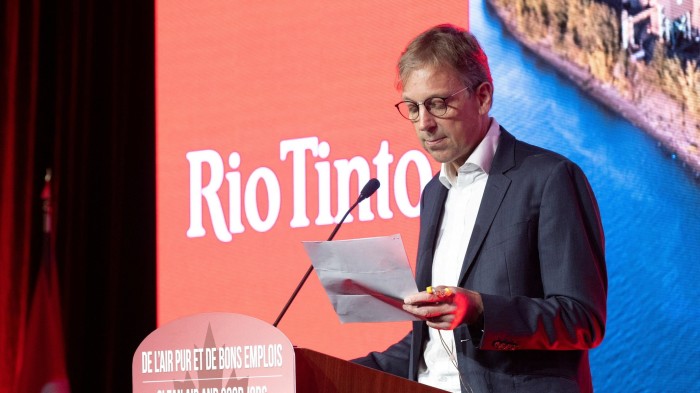Unlock the Editor’s Digest for free
Roula Khalaf, Editor of the FT, selects her favourite stories in this weekly newsletter.
Rio Tinto’s board asked chief executive Jakob Stausholm to step down because its directors wanted someone with more mining experience, in a move that came as a surprise to shareholders.
Stausholm’s departure, announced on Thursday, was amicable but came sooner than expected, according to people familiar with the matter.
The board was seeking someone with more operational experience, with the feeling that Stausholm’s skill set no longer matched the company’s needs, they added.
The world’s second-largest mining company said its chief, who had been in the role for four-and-a-half years, would step down by the end of the year, without naming a successor.
In a statement on Thursday, Rio’s chair Dominic Barton said it was a “natural moment” to find a new leader “as we look ahead to our next phase, in which we will double down to deliver greater operational performance”.
However, several analysts questioned the timing. Ben Davis, analyst at RBC, said it “seemed odd” given that the company was accelerating its lithium investment programme.
One Australian shareholder told the Financial Times he was bemused by the timing of the announcement, which came in the same month as the annual meeting when succession planning would normally be discussed with investors.
He pointed to the chief executive’s public discussion of a plan to raise equity in Australia last February as a possible catalyst for Stausholm’s exit given strong shareholder opposition to the idea.
Rio declined to comment.
There had also been tensions between Stausholm and the board, including regarding Rio’s preliminary merger talks with Swiss miner Glencore on a deal that would have created a resources giant, said three people familiar with the matter. Barton had generally been more supportive of those exploratory discussions than Stausholm, they said.
The talks, which started last autumn, extended into early this year, according to two people familiar with the discussions. The two companies were not currently in active deal discussions, they added.
But the diverging views between Stausholm and the board over the talks were not a reason for his departure, according to one person.
In a period when Rio’s rivals have been pursuing major deals — such as BHP’s unsuccessful £39bn bid for Anglo American last year — Rio has taken a more conservative approach, focusing on building its lithium business despite a downturn in prices for the metal.
Stausholm was appointed chief executive in 2021 with a mandate to help Rio Tinto repair its image and internal culture after the company destroyed a sacred Aboriginal site at Juukan Gorge in the Pilbara region of Western Australia. His efforts were largely seen as a success, according to analysts.
He also oversaw a series of big investments in lithium, a key metal in electric vehicle batteries, spending $6.7bn in cash to buy Arcadium, and investing in new lithium projects in Argentina and Chile.
Stausholm had limited mining experience prior to joining Rio Tinto in 2018, spending most of his career at Shell. Leading internal candidates to replace him include Simon Trott, the Australian head of iron ore, London-based Bold Baatar, chief commercial officer, and Jérôme Pécresse, head of its aluminium operations.
Glyn Lawcock, an analyst with Barrenjoey, said that although the timing of the leadership change appeared sudden, a switch to an operationally-focused leader was expected at some time. “With [the chair] Barton, you have a statesman running the company who can deal with all the politics, who is saying what I need now is someone to drive growth, someone with resources in their blood,” he said.


